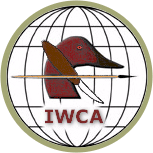An Ohioan's First Foray into Palm Frond Carving
Text and photos by Bob Furia ("MLBob"), West Chester, Ohio
Palm frond decoys are a southern California favorite. But they're beginning to show up in unlikely places. Heck Rice made one for the Rappahannock show on the banks of the Chesapeake, and Bob Furia, from the heartland of America, tried his hand at this unusual decoy style. Results seem to say that good carvers are, well, good carvers!
Sometime during the summer of 2006, UPS delivered a large box to my doorstep. A Long Beach, California return address with the name "Bob Sutton" above it was the only clue to what might be enclosed. Upon opening the box, I was not all that surprised to see a collection of palm fronds with a hastily scribbled challenge scrawled across a piece of the foam packing: "Let's see what you can do with one of these! Have fun! CHEERS, Bob."
Over two months later, the fronds still sat untouched on a corner of my workbench. Then one night as I sat paging through a volume of the collected paintings of Audubon, a depiction of a bird with a distinctive shape jumped out at me. Inspiration reared its unlikely head! I looked to the frond on the workbench.... to the Audubon print of an American coot.... to the frond.... the print....

Grabbing a white-lead pencil, I snatched up the frond and began to sketch lines on its surface. The idea for my first palm frond decoy had been hatched.
After gathering some reference photos of Fulica americana and sketching out a passable head pattern, I went to work with a sharp knife and sandpaper.

A "palm frond carver" had been born!

Even though the lines of the frond lent themselves to an easy interpretation of the way Audubon had captured the essence of the American coot, my background as a maker of gunning-rig birds influenced the construction methods under the carved surface:
- A hardwood dowel was used to pin the head in place.

- I inlaid a channel to accommodate a weighted keel, for if this forward-leaning bird were to be a gunner in my rig, it would not only need to float with the proper attitude, but also self-right. That's just the way we do it on the Ohio River.



Now it was time to seal the carving. Man, does a frond ever soak up sealer! My old mentor, "Buckeye Joe" Wooster, used to maintain that: "Two coats of Val-Oil will seal a cotton ball." Joe's advice was still right.

After the sealer dried, I followed my normal procedures for base coating, texturing, and painting a hunting decoy. In keeping with the simple, clean lines already achieved with the natural flow and shape of the frond—and following Audubon's paint scheme—I held feather details to a minimum.

My plan was to send this bird back to the West Coast to be judged at the California Open and put in the auction to support the show. However, two things needed to happen before I sent it off. First, it had to go to work. After all, it is a working decoy. So, this season, it spent a few days riding the Ohio River in my gunning rig.


Finally, I had to have it inspected by another "old coot." Old-school California frond carvers will recognize Joe Wooster—another Buckeye—who carved a few coots in his day. Joe allowed how it was a "pretty good bird.”

Editor's note: Palm fronds are leaves of one of many species of palm trees. The part of the leaf used by carvers is the hard, fibrous base of the leaf stem, or petiole, that attaches the leaf to the trunk. Softer parts of the leaf die and decay, but the base often remains attached to the trunk. These bases are easily collected but must be processed before they can be used. Frond bases are often covered with sharp spines that have to be removed, and the entire frond must be cut to size.
If you don't live in southern California, fronds may be difficult to find. One supplier, Chet Wilcox, of Wil-Cut Company, and an outstanding carver, supplies fronds along with other specialty woods. Contact Chet at 916-961-5400, or by mail at 7113 Spicer Drive, Citrus Heights, CA 95621.
